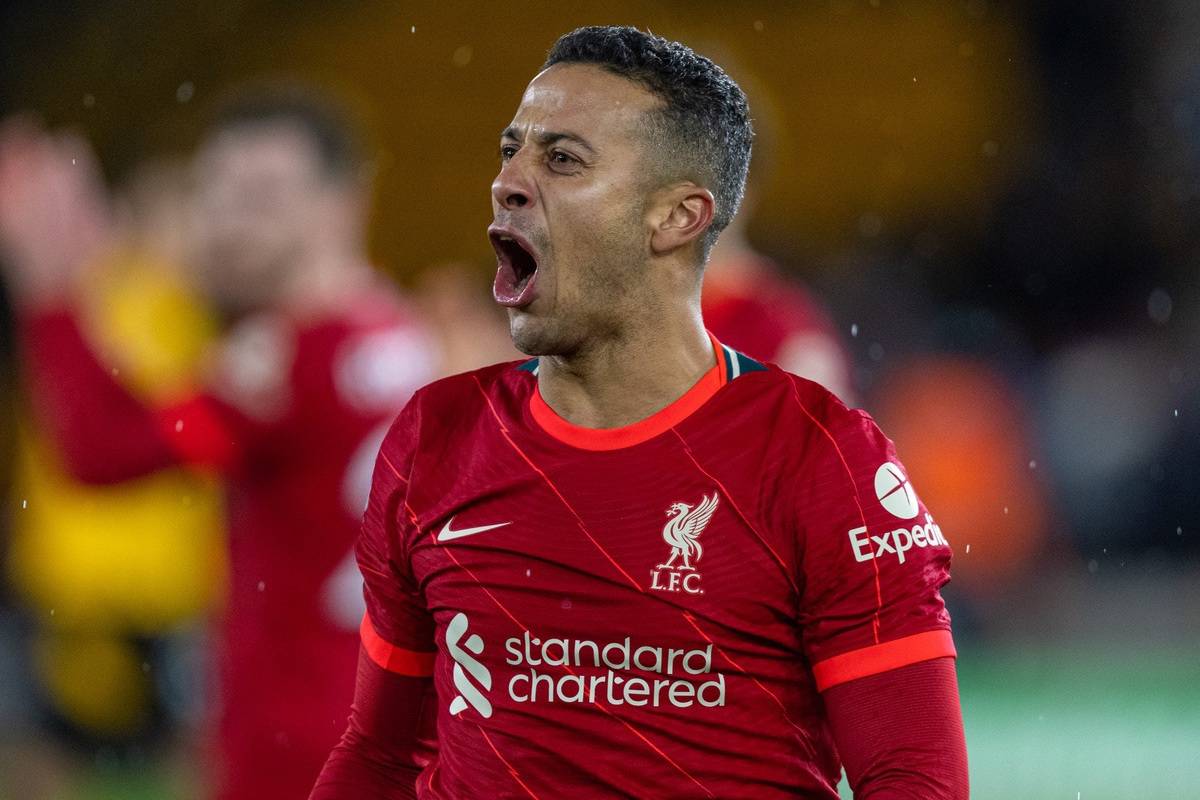
[ad_1]
Thiago was bemusingly criticised by some media in his early beginnings at Liverpool but it is his presence that is offering the Reds a transformational luxury, Sam McGuire writes.
It wasn’t that long ago that the signing of Thiago was being described as an unnecessary luxury. COVID and a long-term injury limited him to just three appearances prior to the turn of the year.
His return coincided with Joel Matip, Liverpool’s last remaining senior centre-back, being sidelined with an injury. The midfield maestro was front and centre during that torrid run of form throughout January and February.
Pundits got fed up talking about the injuries and decided to focus on low-hanging fruit. Thiago was then accused of taking too many touches, playing too many risky passes and just generally looking too sluggish for Premier League football.
He is now making a mockery of those opinions and the world is seeing exactly why the Reds wanted to add him to their ranks.
It’s not really 4-3-3 anymore…
In his seven starts this season (all competitions), Liverpool have racked up 21 goals while conceding just one.
On paper, Jurgen Klopp is still going into matches with a 4-3-3 shape. However, the German tactician has tweaked the way his side build and sustain attacks.
Previously, the Reds had a consistent approach to playing out from the back. Fabinho would drop, the centre-backs would split and the full-backs would push on. Since the last international break, the shape has been completely different:
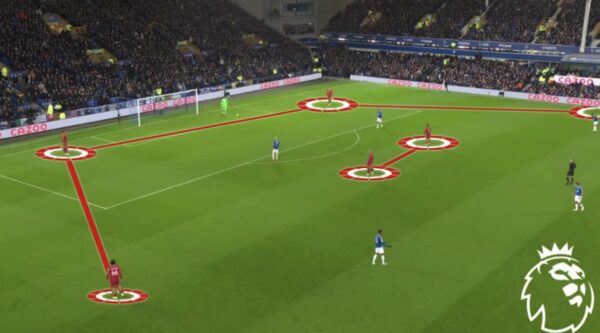
Both Fabinho and Thiago retreat, as shown in the screenshot above, while the right-sided centre-midfielder pushes on.
Instead of progressing up the pitch in the wide areas, Liverpool are doing it from central zones.
The average position map (below), courtesy of Twenty3, shows more of a 4-2-2-2 shape in the emphatic win over Everton:
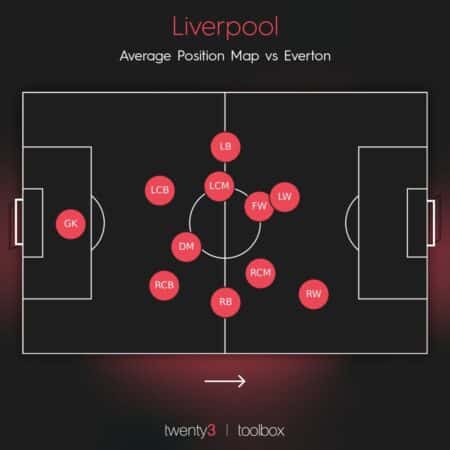
Klopp has been flirting with this idea on-and-off since his arrival – there’s even a feature from 2017 covering this idea.
Following the signing of Fabinho in 2018, both Klopp and Lijnders made reference to him needing to get used to playing as a single pivot in the Liverpool system.
After the 4-0 win over Red Star Belgrade, the former BVB boss joked about the system change: “The present for his birthday was not that he was in the starting line-up, it was that we played his favourite system with a double six.”
People remember Lijnders calling the ex-Monaco destroyer a “lighthouse,” but during the same interview with ESPN, Liverpool’s assistant coach spoke candidly about the No. 3’s adaption to life in the Premier League:
“To adapt to the intensity of our play, that takes time. Not many can do it, and in certain positions, it is easier than others.
“If you are a front player and you come in, and you are used to playing in an attacking way, then it is easier, depending on the specific attributes you have as a player.
“For him, to play in a midfield three as we did at the start of the season, we knew from the first second, we knew from the videos that it would take time.
“His impulse of defending forward is absolutely of the highest level. The question as a No. 6 is that you are moving more side to side than forwards.
“Then of course you have to adapt. And then we find a good solution to change to 4-4-2. And from that moment it helped so much, and then you saw the real Fabinho.”
For the first time since he joined in 2015, Klopp has two players who have experience playing in a double pivot and it is why we’re likely going to see more of this two-man midfield in possession for the remainder of the season.
The balance is there and, perhaps more importantly, the movements between the two are natural.
They hunt together and cover for one another. The space they are tasked with dominating is smaller and it is one of the reasons the Reds have been as rampant as they have recently. They have two centre-midfielders and two centre-backs patrolling the middle third and then the other six players are able to impact things in the final third.
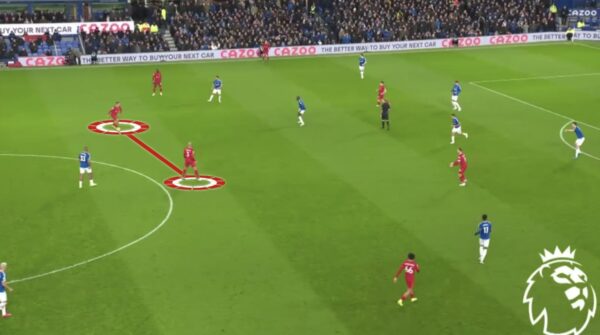
You can see it during the Everton game (above). There is a solid base and then the rest occupy the spaces around them. In this particular situation, Henderson and Diogo Jota are occupying the centre-forward roles.
Jota, another September 2020 arrival, is also benefitting from this new shape.
Knock-on effect
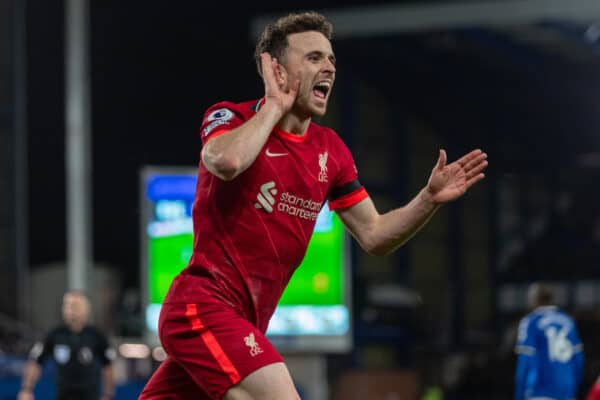
During Jota’s time with Wolves, he would often play in a two-man attack alongside Raul Jimenez. At Liverpool, he’s been tasked with leading the line as a sole No .9.
But this subtle tweak to the right-sided centre-midfielders role has seen him have something of a strike partner. The Portuguese speedster is able to drop deep knowing the centre-backs are occupied. He is also able to play on the shoulder of the last man, safe in the knowledge that the free midfielder is filling the space more commonly tied to a No. 10.
The third midfielder is now playing the Roberto Firmino role – offering himself on either flank to allow play to progress.
The big difference is that the Reds have a link player and a penalty-box poacher.
It is no longer a choice of either/or. They’re in such a luxurious position, ironically, because of the signing of Thiago.
[ad_2]
Source link

